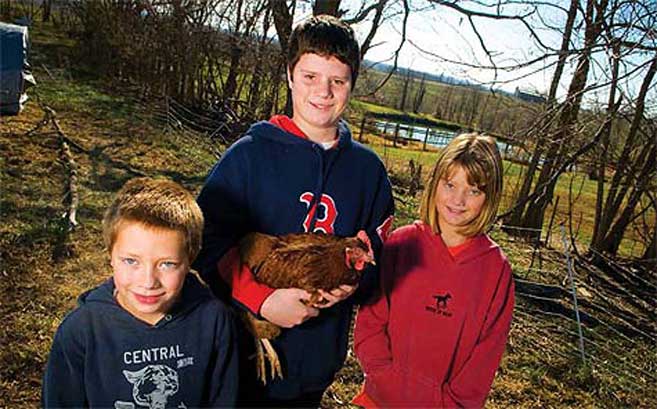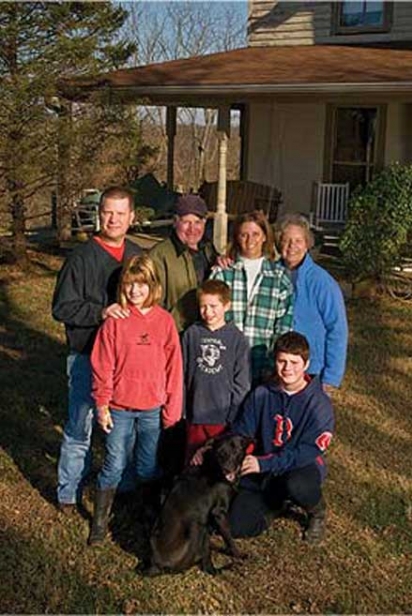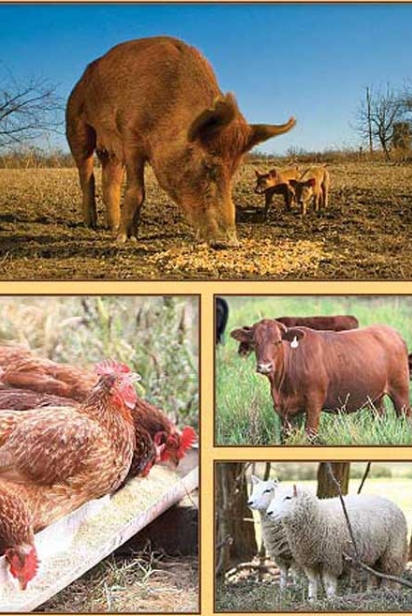Healthy Animal Lifestyles at Stone Run Farms
What’s best for the animals? What’s best for you?
“It sounds far-out,” says Arthur Young of Stone Run Farms, “but I’m a harvester of solar energy.”
Stone Run’s solar panels are blades of pasture grass. Their energy converters run around the farm bleating, oinking, clucking and mooing. Their customers enjoy plates full of sunshine at mealtimes—as pork tenderloin, Italian sausage, lamb chops, roasted chicken and farm-fresh omelets.
A Kentucky farmer his entire life, at 73 Arthur has seen it all. “I cut my teeth on tobacco farming,” he explains. But Mr. Young isn’t looking back to the good old days. On the contrary, when Kentucky’s tobacco buyout came along, he was eager to leave the old cash crop behind. “I was sick and tired of growing a product that made you sick,” says Young.
Health now lies at the heart of the Young’s recently transformed family farm in Washington County—the health of their customers and the land.
When former nurse Shannon Young—Arthur’s daughter-in-law—decided to join Stone Run as a fulltime farmer, she was determined not to leave her passion for healthcare behind. In fact, she is now working harder than ever to care for people—this time by supporting the farm’s “one-stop protein shop” in the field, at the market and online.
Official farm mom Martha Young was herself a hospital administrator for many years. For the health of her family she has always kept up the rural 1950s traditions she was raised with: home cooking from fresh, whole foods and home canning local garden products.
Martha wasn’t quite sure what “Dad” was up to when he began investing in the heritage breeds of farm animals that now populate their 450 acres, “but I knew he was getting excited,” she says.
HEALTHY LIFESTYLES FOR HEALTHY FOOD ANIMALS
While Shannon teaches a wobbly orphan lamb to suckle from a milk dispenser, she explains how grass-fed protein includes more of the good fats—omega-3s and CLA (conjugated linoleic acid)—while factory-farm animals, raised primarily on grain, contain higher levels of omega-6 and saturated fat.
The bright orange yolks from Shannon’s Rhode Island Red chicken eggs speak for the high content of beta-carotene that stems from a diet of fresh grass, also known to provide folic acid and vitamin E.
Shannon keeps her chickens in easily movable pens, so that she can shift them to fresh patches of green as needed. The birds have a smorgasbord of insects available for protein, and a life of fresh air, sunshine and plenty of exercise. For both meat and eggs, this healthy lifestyle translates to richer vitamin and antioxidant content, with no need for antibiotics or growth hormones.
Stone Run’s chickens recall to customers the dense, deep flavor and texture of old-fashioned, all-natural poultry. Shannon introduced her meat chickens and Rhode Island Red layers and stewing hens to the family business in 2008. She has converted her spacious backyard into a barnyard for the poultry, and for lambs sometimes orphaned at the larger farm, just a few miles down the road.
Arthur first brought sheep to work for Stone Run as wooly weed-eaters. In order to prepare the land for sustainable, lowinput pasturing, he needed a clean-up team, so he invested in sheep, choosing heritage breeds—Romney and Dorset—for the rams. Modern, industrial farm animals are bred for captivity and grain-feeding, but the Youngs wanted the more resilient, classic strains that can take care of themselves—thus requiring less expense in terms of food and shelter.
“Selling lambs for meat,” says Martha, “was an afterthought.”
But when the extension agent called on behalf of the Keeneland Racetrack office— seeking fresh dinner lamb for a family of Arabian horse-farmers—the Youngs realized they could maintain their four-legged groundskeeping crew by capitalizing on this niche market. Soon, they found that the British community in Kentucky was also looking for local lamb.
Now the Youngs are marketing around 70 lambs per season—as lamb chops, rack of lamb, leg of lamb, stew meat, boneless shoulder and even ground lamb. They’re pleased to find that an increasing number of Kentuckians are happily embracing this source of protein.
Life on the farm got even more interesting when Arthur pulled up in the driveway one day with a wagon full of hairy red hogs. “That’s how it works in this family,” says Martha.
He had thoroughly researched the pig world before investing in Tamworths, a heritage breed that provides much of its own food supply by foraging, and doesn’t require shelter, even in the winter.
Tamworths are known historically as a bacon breed. Highly active, even athletic, these pigs don’t just wallow around taking lazy mud baths—they forage for a living. Together with this exercise, their diet of grass, acorns, nuts, berries and roots creates a leaner, finer-grained meat. They also have a high meat-to-bone ratio.
The Youngs sell loin roast, tenderloin, cutlets, Boston butt, ham roast, ribs, six kinds of sausage (including bratwurst), bacon and ground pork.
HERITAGE BREEDS
The American Livestock Breeds Conservancy (ALBC) is a nonprofit membership organization that started working in 1977 to protect historic breeds and diversity of livestock. Because modern food production favors the use of a few highly specialized breeds selected for maximum output in a controlled environments, breeds with other positive characteristics face diminishing populations. These breeds are referred to as “heritage.”
Unlike many of their modern cousins, heirloom breeds of farm animals have not been genetically degraded by breeding practices that increasingly prepare animals for industrial feedlots, unnatural confinement, corn and grain diets, growth hormones and antibiotics. They are often known for strong mothering tendencies, high fertility, thriving in challenging environments and strong offspring survival rates.
TAMWORTH PIGS | This rather distinguished swine was first bred in 1812 by the English Prime Minister Sir Robert Peel of Tamworth, who crossed local pigs with stock from Ireland. Selected over centuries for hardy, outdoor living, Tamworths never require confinement, even in the winter, their furry red coats protecting them from sunburn in summer as well. They aren’t just free-ranging, they’re wide-ranging—with long legs and strong feet allowing them to travel great distances in search of forage. Believed to be the most direct descendents of Europe’s native pig stock, they are currently considered a “threatened” breed.
ROMNEY SHEEP | Native to Kent, England, this dual-breed sheep is known for both fine wool and good meat production. They first came to America in 1904 and are extremely common in New Zealand, producing wool and frozen lamb for export. Their lean, well-muscled flesh is typically graded as prime or choice. They are known for their delicate taste, even in older lambs. They are an old breed but not endangered.
DORSET SHEEP | Perhaps bred from a cross between the Merino sheep of Spain and the Horned sheep of Wales during the earliest days of Spanish and English contact, this breed spread to the Dorset, Somerset and Devon counties of England, as well as most of Wales. Dorset ewes are known to be good mothers and strong milkers, often providing multiple births. While most sheep commonly breed in the fall for spring births, Dorsets can also breed in spring.
DEVON CATTLE | Devon cattle were the first to come to America with the colonists, their robust constitution helping them to survive the long ocean voyage and frontier challenges. Taking their name from Devon County, England, they were known to exist as early as 200 BC—when Britain was an outpost of the Roman Empire. They are believed to have originated in Africa. It’s a hardy breed indeed that can withstand the hot-dry of Africa, the cool-damp of England and the sometimes hot-humid, sometimes frozen-cold of Kentucky. They are classified as a “recovering” breed by the ALBC after nearing extinction in the 1950s.
RHODE ISLAND RED CHICKENS | This barnyard star typically lays from 250 to 300 eggs a year. Although they make great pets, the roosters can also become a bit aggressive. Rhode Island Reds are particularly resilient to illness. If exposed to direct sun for prolonged periods, rather than sunburning, their bright colors will begin to fade. ALBC lists the breed as “recovering.”
SUSTAINABLE FARMING FOR A HEALTHY FUTURE
Arthur manages the Stone Run operation through a complex method of sustainable agriculture with a deceptively simple name: grass farming.
In addition to the pigs and sheep kept at the larger farm, a herd of cattle — not yet available to customers as grass-fed beef — are a key element in the pasture rotation system. Arthur has chosen Devon bulls, an heirloom breed known for their vitality, to sire his herd.
Stone Run’s goals are to keep the land as healthy as possible, so that inputs of feed and chemicals can be kept to a minimum. This allows the farm to produce meat more affordably, and to provide a healthier product for the customer, but the apparent win-win-win situation comes at a cost: It ain’t easy!
Arthur explains: “Every day I have to ask, ‘What’s best for the cattle? What’s best for the soil? What’s best for me?’” He laughs and adds, “If all this thinking keeps me from getting Alzheimer’s, that will be the biggest payoff!”
Grass farmers believe that as the energycapturing medium between sun and soil, healthy grass needs to be the farmer’s true focus — even if meat and eggs are the products for sale at the farmers’ market. Energy is, after all, what’s being transferred from the sun to the human consumer, via the grass and the animals that eat it.
In addition to the intellectual demands, this management-intensive grazing approach requires Arthur to frequently walk his land to stay in tune with the health of the many grasses and other plants supporting his animals. When nature tells him the time is right, he then has to wrangle his sheep and cattle from one paddock — a subdivision of the pasture — to another, a task requiring plenty of get-up-and-go.
Grass farming encourages great biodiversity among the varieties of plants that grow in the paddocks throughout the changing seasons, while the animal manures fertilize the soil with a balance of nutrients for further grass production.
Even during the high drought summers Kentucky has experienced in recent years, Stone Run did not need to buy any additional hay for their animals. A healthy polyculture of grasses allows for deep-rooted species to take over when the going gets tough. The Young family hasn’t needed to buy fertilizer in years.
Martha describes grass farming as “our ace in the hole.”
After decades during which America’s family farms have dwindled, and appeared to be perhaps even disappearing into the sunset, sustainable agriculture — despite its demands on the farmers’ brains and brawn — might just offer a promising new dawn.
Stone Run Farms’ pastured poultry, lamb, and pork are available at Saturday mornings through the market season at Norton Commons farmers’ market, 9420 Norton Commons Blvd. in Prospect, and on Thursday afternoons at the Suburban Christian Church farm market, 7515 Westport Road. In the winter, pork and poultry can be purchased at Foxhollow Farm Store, 8905 Hwy 329 near Crestwood. You can reach Shannon Young at info@stonerunfarms.com and get more information at www.stonerunfarms.com







